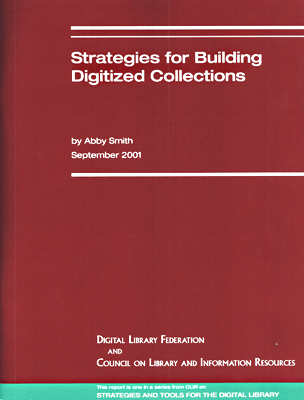
by Abby Smith
September 2001
Copyright 2001 by the Council on Library and Information Resources. No part of this publication may be reproduced or transcribed in any form without permission of the publisher. Requests for reproduction should be submitted to the Director of Communications at the Council on Library and Information Resources.
- 1.1. Defining a Sustainable Strategy
- 2.1. Policies, Guidelines, and Best Practices
- 2.2. Rationales for Digitization
- 2.2.1. Preservation
- 2.2.1.1. Surrogates
- 2.2.1.2. Replacements
- 2.2.2. Access
- 2.2.2.1. Access for Outreach and Community Goals
- 2.2.2.2. Building Collections
- 2.2.2.3. Meeting Use and Infrastructure Needs
- General Collections
- Special Collections
- 2.2.1. Preservation
- 3.1. Treatment and Disposition of Source Materials
- 3.2. Scalability
- 3.3. Intellectual Control and Data Management
- 3.4. Coordinated Collection Development
- 3.5. Funding
- 3.6. Preservation
- 3.7. Support of Users
- 4.1. Costs
- 4.2. Benefits
- 4.3. Looking Ahead
- 4.4. Recommendations
About the Author
Abby Smith is director of programs at the Council on Library and Information Resources (CLIR). She is responsible for developing and managing collaboration with key library and archival institutions to ensure long-term access to our cultural and scholarly heritage. Before joining CLIR in 1997, she had worked at the Library of Congress for nine years, first as a consultant to the special collections research divisions, then as coordinator of several cultural and academic programs in the offices of the Librarian of Congress and the Associate Librarian for Library Services. She directed a preservation microfilming program in the former Soviet Union, curated three exhibitions of Russian library and archival treasures from the former Soviet Union, and was curator and project director for the library’s first-ever permanent exhibition of its holdings, Treasures of the Library of Congress.
Acknowledgments
This report would not have been possible without the cooperation of the six libraries that opened their doors to me, invited my direct questions, and answered them frankly and with great thoughtfulness. I thank the library directors and their staff at Cornell University, the New-York Historical Society, The New York Public Library, New York University, the University of Michigan, and the University of Virginia. I profited from their time, attention, and careful review of a preliminary draft for accuracy. Others who have read this report in various drafts and offered their suggestions for improvement include Ross Atkinson, Ricky Erway, Dale Flecker, Janet Gertz, Peter Hirtle, Anne Kenney, and Bonnie MacEwan. I worked closely with Daniel Greenstein, Tim Jewell, and Lou Pitschmann in developing a framework for this report and reviewing each draft. My special thanks go to Kathlin Smith, the ideal editor.
Preface
In January 2000, the Digital Library Federation (DLF) launched an informal survey to identify the major challenges confronting research libraries that use information technologies to fulfill their curatorial, scholarly, and cultural missions. With astonishing unanimity of opinion and clarity of voice, respondents pointed to digital collection development as their single greatest challenge. Whether the digital information came from a commercial publisher or from a digitization unit within the library, it seemed to exist under a cloud of profound and unsettling uncertainty. Would it be useful and useable in its present or intended form, or require additional work by catalogers, systems staff, or subject bibliographers? What new demands would its availability make on library reference staff? What level of continued investment would be necessary to ensure its accessibility on current hardware and software?
The survey also revealed that leading research libraries had learned a great deal about their digital collections through experience. Though substantial, that learning had rarely been expressed outside the collection policies, working papers, and implementation guidelines that libraries create to coordinate and manage their collection development efforts. Accordingly, in April 2000, the DLF commissioned three reports to address broader concerns about digital collections. They are: Building Sustainable Collections of Free Third-Party Web Resources, by Louis Pitschmann, Selection and Presentation of Commercially Available Electronic Resources: Issues and Practices, by Timothy Jewell, and the report before you. The reports mark a starting point for what we hope will emerge as an evolving publication series.
Working to a common outline and based on the lessons of experience, the authors demonstrate how decisions taken by a library when acquiring (or creating) electronic information influence how, at what cost, and by whom the information will be used, maintained, and supported. By assembling and reviewing current practice, the reports aim where possible to document effective practices. In most cases, they are able at least to articulate the strategic questions that libraries will want to address when planning their digital collections.
In this report, Abby Smith synthesizes the nearly 10 years’ experience that libraries have had digitizing items from their rare, special, and general collections, and making them available online. The learning she uncovers is distilled in and extended by several case studies conducted in leading digital libraries with very different digitization programs. Smith demonstrates that digitization programs work best where their role within a library’s collection development strategy is clearly understood, and she identifies several roles that such programs can play. Smith also asks a number of searching questions. She muses about the extent to which digitally reformatted special and rare collections can actually support scholarly research. Probing further, she wonders whether leading research libraries in particular might more usefully focus on digitizing general as opposed to special and rare collections. In this way, they would make important holdings available in new ways while taking a first step in avoiding costs associated with their redundant management. The report is consequently much more than a strategic guide for individual institutions; it is a route map that points important directions for the library community as a whole.
Daniel Greenstein
Director, Digital Library Federation

